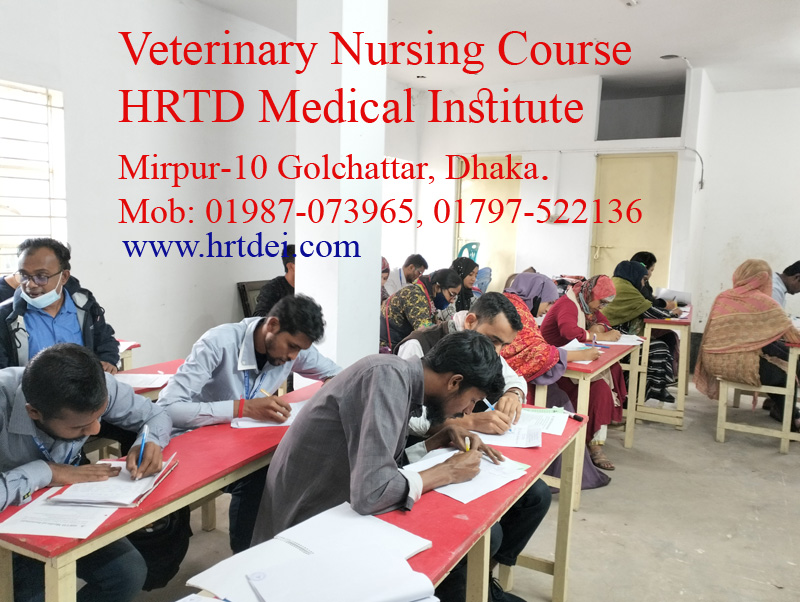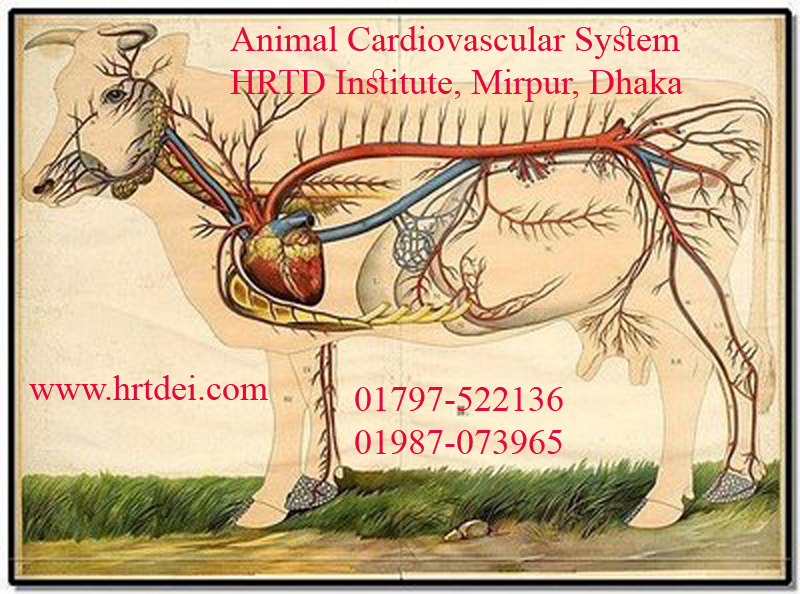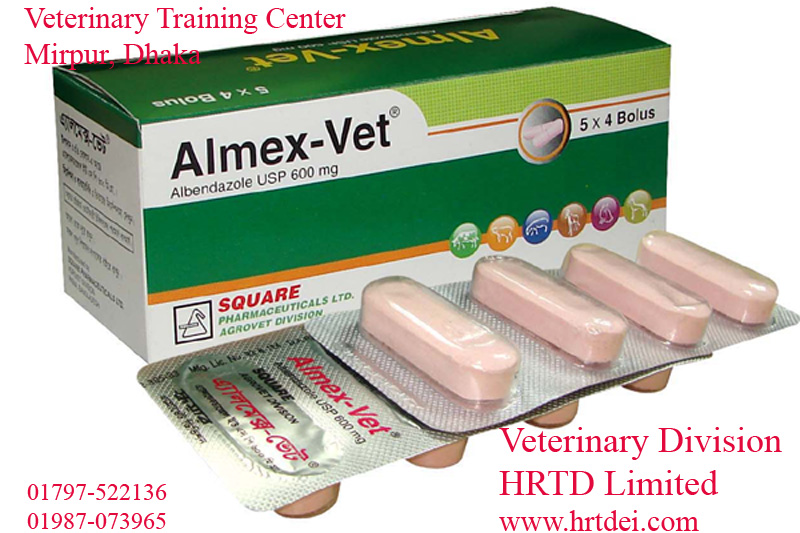Veterinary Nursing Course in Dhaka
Best Veterinary Nursing Course. Mobile No. 01797-522136, 01987-073965. Veterinary Nursing Course 6 Months, Veterinary Nursing Course 1 Year, Veterinary Nursing 2 Years, Veterinary Nursing 3 Years, Veterinary Nursing 4 Years. Other Courses at HRTD Medical Institute are Human Nursing Course, Pharmacy Course, Paramedical Course, Dental Course, Pathology Course, Physiotherapy Course, LMAF Course, Veterinary Course, Homeopathy Course, Post Diploma Training Course, etc.

Location of Veterinary Nursing Training Center
Veterinary Nursing Course. Mobile Phone No. 01797-522136, 01987-073965. HRTD Medical Institute, Abdul Ali Madbor Mansion, Section-6, Block-Kha, Road-1, Plot-11, Metro Rail Piller No. 249, Mirpur-10 Golchattar, Dhaka-1216.
Qualification for Admission to Veterinary Nursing
Qualification for admission: Mobile Phone No. 01797-522136, 01987-073965. SSC Pass/ SSC Equivalent/ HSC Pass/Degree Pass/ Masters Pass.
Papers for Admission to Veterinary Nursing
Papers for Admission: Mobile Phone 01797-522136, 01987-073965. Photocopy of all Certificates, Photocopy of NID, PP Size Photo 4 Pcs.
Course Fee for Veterinary Nursing
Course Fee for Veterinary Nursing. Mobile No. 01797-522136, 01987-073965. Veterinary Nursing Course 6 Months Tk 26500/-, Veterinary Nursing Course 1 Year Tk 52500/-, Veterinary Nursing 2 Years Tk 92500/-, Veterinary Nursing 3 Years Tk 142500/-, Veterinary Nursing 4 Years Tk 182500/-.
Admission Fee and Monthly Fee for Veterinary Nursing
Admission Fee & Monthly Fee. Mobile No. 01797-522136, 01987-073965. Veterinary Nursing 6 Months Admission Fee Tk 10500/-, Monthly Fee Tk 3000/-, Exam Fee Tk 3000 + Tk 3000/-, Veterinary Nursing Course 1 Year Admission Fee Tk 10500/-, Monthly Fee Tk 3000/-, Veterinary Nursing Course 2 Years Admission Fee Tk 16500/-, Monthly Fee Tk 3000/-, Veterinary Nursing Course 3 Years Admission Fee Tk 20500/-, Monthly Fee Tk 3000/-, and Veterinary Nursing Course 4 Years Admission Fee Tk 30500/-, and Monthly Fee Tk 3000/-.
Subjects of Veterinary Nursing
Veterinary Nursing Subjects. Mobile No. 01797-522136, 01987-073965. Veterinary Anatomy, Veterinary Physiology, Veterinary Microbiology, Veterinary Hematology, Veterinary Pathology, Veterinary Pharmacology, Practice of Veterinary Medicine, Animal Infectious Disease, Poultry Infectious Disease, Veterinary Farm Management, Bio Security, Animal Vaccination, Poultry Vaccination, Veterinary Cardiovascular Nursing, Veterinary Gynecological Nursing, Veterinary Clinical Nursing, Veterinary General Nursing, Veterinary First Aid, Veterinary Emergency Management, Animal Nutrition, Poultry Nutrition, Veterinary Midwifery etc.
Veterinary Anatomy & Physiology
Veterinary Anatomy & Physiology. Veterinary Anatomy includes Animal Anatomy, Animal Physiology, Poultry Anatomy, and Poultry Physiology. Animal Anatomy describes the structures of the tissue, organs, and systems of an animal body. Animal Physiology describes the functions of cells, tissues, organs, and systems of an animal body. Poultry anatomy describes the structures of the poultry body and poultry physiology describes the functions of the poultry body.
ভেটেরিনারি অ্যানাটমি হলো পশুর শারীরিক গঠন ও অঙ্গ-প্রত্যঙ্গের বিজ্ঞান, যেখানে পশুর বিভিন্ন অংশের আকার, অবস্থান এবং তাদের পারস্পরিক সম্পর্ক নিয়ে আলোচনা করা হয়। অন্যদিকে, ভেটেরিনারি ফিজিওলজি হলো পশুর দেহের বিভিন্ন অঙ্গ-প্রত্যঙ্গের কার্যকারিতা এবং তাদের কাজ করার প্রক্রিয়া নিয়ে আলোচনা করা।

ভেটেরিনারি অ্যানাটমি (Veterinary Anatomy)
- সংজ্ঞা:এটি পশুর দেহের বিভিন্ন অংশ, যেমন – কোষ, টিস্যু, অঙ্গ এবং অঙ্গতন্ত্র (organ systems) এর গঠন, আকার ও বিন্যাস নিয়ে অধ্যয়নের বিজ্ঞান।
- মূল বিষয়:পশুদের অঙ্গ-প্রত্যঙ্গগুলো দেখতে কেমন, সেগুলো কোথায় অবস্থিত, এবং কীভাবে একে অপরের সাথে সংযুক্ত থাকে, তা এই শাস্ত্রে বিশ্লেষণ করা হয়।
- গুরুত্ব:পশুর অভ্যন্তরীণ অঙ্গগুলোর গঠন সম্পর্কে সঠিক জ্ঞান থাকলে তাদের বিভিন্ন রোগ বা আঘাত নির্ণয় ও চিকিৎসায় সুবিধা হয়।
ভেটেরিনারি ফিজিওলজি (Veterinary Physiology)
- সংজ্ঞা:এই শাস্ত্র পশুর দেহের বিভিন্ন অঙ্গ, অঙ্গতন্ত্র, এবং তাদের কোষগুলোর কার্যকারিতা ও কাজ করার প্রক্রিয়া নিয়ে আলোচনা করে।
- মূল বিষয়:পশুর দেহের বিভিন্ন জৈবিক প্রক্রিয়াগুলো কীভাবে পরিচালিত হয়, যেমন – শ্বাস-প্রশ্বাস, পরিপাক, রক্ত সঞ্চালন ইত্যাদি, তা এই শাস্ত্রে অধ্যয়ন করা হয়।
- গুরুত্ব:দেহের বিভিন্ন অঙ্গের স্বাভাবিক কার্যক্রম ও কার্যকারিতা বুঝতে পারলে রোগ বা শারীরিক সমস্যা হলে তার কারণ ও প্রতিকার খুঁজে বের করা সহজ হয়।
Importance Of Veterinary Anatomy & Physiology
- রোগ নির্ণয় ও চিকিৎসা:পশুর শারীরিক গঠন ও কার্যকারিতা জানা থাকলে veterinarians (পশুচিকিৎসক) বিভিন্ন রোগ সঠিকভাবে নির্ণয় ও চিকিৎসা করতে পারেন।
- প্রজনন ও উৎপাদনশীলতা:অ্যানাটমি ও ফিজিওলজি পশুর প্রজনন প্রক্রিয়া এবং উৎপাদনশীলতা বাড়াতে সাহায্য করে।
- সার্জারি ও চিকিৎসা পদ্ধতি:বিভিন্ন অস্ত্রোপচার (যেমন, অর্থোপেডিক) এবং অন্যান্য চিকিৎসা পদ্ধতির জন্য পশুর শরীর সম্পর্কে বিস্তারিত জ্ঞান অপরিহার্য।
- খাদ্য ব্যবস্থাপনা:পশুর পুষ্টি এবং খাদ্য ব্যবস্থাপনার জন্য তাদের পরিপাকতন্ত্রের গঠন ও কার্যপ্রণালী বোঝা জরুরি।
- প্রতিরোধ ও প্রতিরোধ:পশুর শরীর কীভাবে কাজ করে তা জানার মাধ্যমে রোগ ও স্বাস্থ্য সমস্যা প্রতিরোধ করা সম্ভব।
- বিশেষায়িত জ্ঞান:বিভিন্ন প্রজাতি যেমন, পাখি, উট, বা গবাদি পশুর ক্ষেত্রে তাদের নির্দিষ্ট অ্যানাটমি ও ফিজিওলজি জানা থাকা প্রয়োজন।
Main Body Systems in Veterinary
1. Skeletal System
- Function: Supports the body, protects internal organs, allows movement, stores minerals, and produces blood cells (in bone marrow).
- Organs/Parts: Bones, joints, cartilage, ligaments.
- Species Note: Horses walk on a single digit (toe), cows have cloven hooves (two digits).
2. Muscular System
- Function: Enables movement, maintains posture, and produces heat.
- Types of Muscle:
- Skeletal (voluntary movement),
- Cardiac (heart),
- Smooth (internal organs like intestines and blood vessels).
3. Nervous System
- Function: Coordinates and controls body activities; processes sensory information.
- Organs/Parts: Brain, spinal cord, peripheral nerves, sensory organs.
- Divisions:
- Central Nervous System (CNS): brain + spinal cord
- Peripheral Nervous System (PNS): nerves outside CNS
4. Circulatory (Cardiovascular) System
- Function: Transports oxygen, nutrients, hormones, and removes wastes.
- Organs/Parts: Heart, arteries, veins, capillaries, blood.
5. Respiratory System
- Function: Delivers oxygen to the blood and removes carbon dioxide.
- Organs/Parts: Nostrils, trachea, bronchi, lungs, diaphragm.
- Species Note: Birds have air sacs; horses cannot breathe through their mouths.
6. Digestive System
- Function: Breaks down food, absorbs nutrients, eliminates waste.
- Organs/Parts: Mouth, esophagus, stomach, intestines, liver, pancreas.
- Species Note:
- Ruminants (cows, sheep): 4-chambered stomach
- Monogastric (dogs, cats): single stomach
- Hindgut fermenters (horses, rabbits): ferment food in large cecum
7. Urinary System
- Function: Eliminates waste products from the blood, regulates fluid balance and blood pressure.
- Organs/Parts: Kidneys, ureters, bladder, urethra.
8. Endocrine System
- Function: Produces hormones to regulate metabolism, growth, reproduction, and stress responses.
- Glands: Pituitary, thyroid, adrenal, pancreas, ovaries, testes.
9. Reproductive System
- Function: Produces offspring, hormones related to sexual function and pregnancy.
- Male Organs: Testes, penis, prostate.
- Female Organs: Ovaries, uterus, cervix, vagina, mammary glands.
- Species Note: Birds and reptiles use a cloaca for reproduction and excretion.
10. Integumentary System
- Function: Protects the body, regulates temperature, provides sensory input.
- Parts: Skin, fur/hair, hooves, nails, sweat glands, feathers (in birds).
11. Lymphatic / Immune System
- Function: Protects the body from disease, filters lymph, produces white blood cells.
- Organs: Lymph nodes, lymph vessels, spleen, thymus, tonsils.
Veterinary Pharmacology
Veterinary Pharmacology describes the drugs and medicines that are used for the treatment of animal and poultry diseases. Common Veterinary Drugs are Antibiotic Drugs, Anthelmintic Drugs, Pain Killer Drugs, Bronchodilator Drugs, Anti Ulcer Drugs, Anti Histamine Drugs, Anti Protozoa Drugs, Vitamins and Minerals. Veterinary Pharmacology describes the mode of action, Indications, Contraindications, Dosage form, Dose, Side effects, Pregnancy Category, Storage, and Drug Interactions of the drugs.

Practice of Veterinary Medicine
Practice of Veterinary Medicine is a Veterinary Subject that describes diseases in detail like name of the disease, causes of the disease, clinical features of the disease, diagnosis of diseases, treatment of diseases, and complications of diseases. Animal diseases are Anthrax, Black Quarter, Haemorrhagic Septicemia, Bovine Viral Diarrhea, Foot and Mouth Disease ( FMD), etc.
Veterinary First Aid
Veterinary First Aid is a subject that describes cleaning, dressing, bandaging, shock, classification of shock, causes of shock, stages of shock, clinical features of shocks, first aid of shock, first aid of burn, first aid of cut, first aid of trauma, first aid of snake bite, hypovolemic shock, cardiogenic shock, neurogenic shock, burn shock, electric shock, anaphylactic shock.
Veterinary Microbiology for Veterinary Nursing
Veterinary Microbiology is a subject that describes microorganisms, especially pathogenic microorganisms. Microorganisms are bacteria, viruses, fungi, and protozoa. Pathogenic microorganisms are those that create diseases by infections. These diseases are called infectious diseases. Infectious Diseases are Anthrax, Foot and Mouth diseases, Bovine Viral Diarrhea etc.
Other Veterinary Courses of HRTD Medical Institute
Other Veterinary Course. Mobile No. 01797-522136, 01987-073965. LMA Vet 6 Months, LMA Vet 1 Year, Vet Pharmacy 3 Months, Vet Pharmacy 6 Months, Vet Pharmacy 1 Year, Vet Pharmacy 2 Years, Vet Pharmacy 3 Years, RMP Vet 6 Months, RMP Vet 1 Year, Para Vet 1 Year, Para Vet 2 Years, Para Vet 3 Years, DMA Vet 1 Year, DMA Vet 2 Years, DMA Vet 3 Years, DMS Vet 1 Year, DMS Vet 2 Years, DMS Vet 3 Years, DMDS Vet 4 Years.
Veterinary Midwifery Training
Veterinary Midwifery is a subject of Veterinary Gynecology. Students can learn midwifery tools and midwifery techniques by studying this subject. Midwifery means the calf delivery of a pregnant cow and another female animal. This subject is useful and important for the students because maximum earnings depend on calf delivery.
Veterinary Nursing Pharmacology
1. Definition
Veterinary pharmacology is the study of drugs and their effects on animals. In veterinary nursing, it focuses on the safe preparation, administration, monitoring, and record-keeping of medications for animals.
Scope in Veterinary Nursing
- Understanding drug classifications
- Correct dosage calculation (based on body weight/species)
- Safe routes of administration
- Monitoring therapeutic and adverse effects
- Preventing drug interactions
- Educating animal owners about medicine use
Drug Classifications (Common in Veterinary Nursing)
A. By Action
- Analgesics → Pain relief (e.g., NSAIDs, opioids)
- Antipyretics → Fever reducers
- Antibiotics → Bacterial infections (e.g., penicillin, tetracycline)
- Antiparasitics → Internal & external parasites (e.g., ivermectin, fenbendazole)
- Sedatives & Anesthetics → For surgery & restraint (e.g., xylazine, ketamine)
- Cardiac drugs → Heart conditions (e.g., digoxin, furosemide)
- Hormones → Insulin, thyroxine, reproductive hormones
B. By System
- Gastrointestinal drugs (antiemetics, antacids, laxatives)
- Respiratory drugs (bronchodilators, expectorants)
- Urinary drugs (diuretics, urinary acidifiers/alkalinizers)
- Neurological drugs (anticonvulsants, tranquilizers)
4. Routes of Drug Administration
- Oral (PO) → tablets, capsules, liquid
- Parenteral → IV, IM, SC, intradermal
- Topical → creams, ointments, sprays
- Inhalation → anesthetic gases, bronchodilators
- Otic / Ophthalmic → ear and eye drops
5. Pharmacokinetics (ADME)
- Absorption → How drug enters bloodstream
- Distribution → How drug spreads in body
- Metabolism → How liver (mainly) breaks it down
- Excretion → How drug leaves body (urine, bile, milk, sweat)
6. Nursing Responsibilities
- Calculate accurate dose (mg/kg)
- Choose the right route & technique
- Follow 5 rights of medication:
- Right patient (animal)
- Right drug
- Right dose
- Right route
- Right time
- Maintain sterility during injections
- Monitor for side effects
- Keep medical records
- Guide owners about storage, administration, withdrawal period (for food animals)
7. Examples of Common Veterinary Drugs
- Antibiotics: Amoxicillin, Enrofloxacin
- NSAIDs: Carprofen, Meloxicam
- Antiparasitics: Ivermectin, Albendazole
- Anesthetics: Ketamine, Isoflurane
- Sedatives: Xylazine, Diazepam
Veterinary Nursing Microbiology
Veterinary Nursing Microbiology হলো ভেটেরিনারি সায়েন্সের একটি গুরুত্বপূর্ণ বিষয়। এটি মূলত জীবাণুসমূহ (bacteria, virus, fungi, parasites, protozoa) ও তাদের প্রাণীর শরীরের সাথে সম্পর্ক নিয়ে আলোচনা করে। ভেটেরিনারি নার্সদের জন্য মাইক্রোবায়োলজি জানাটা খুব জরুরি, কারণ এটি প্রাণীর রোগ নির্ণয়, প্রতিরোধ ও চিকিৎসায় সরাসরি কাজে লাগে।
Veterinary Nursing Microbiology এর মূল বিষয়সমূহ
1. Introduction to Microbiology
- Microorganism কী
- Classification of microbes (Bacteria, Virus, Fungi, Protozoa, Parasites)
- Microbial morphology and structure
2. Bacteriology
- Gram-positive ও Gram-negative bacteria
- Pathogenic bacteria (E. coli, Salmonella, Staphylococcus, Streptococcus ইত্যাদি)
- Bacterial culture, staining (Gram’s stain, Ziehl-Neelsen stain)
- Bacterial diseases in animals
3. Virology
- Virus এর গঠন ও replication
- Common veterinary viruses (Rabies virus, Foot and Mouth Disease virus, Avian Influenza virus, Canine Distemper virus)
- Viral transmission ও control
4. Mycology (Fungi)
- Yeast ও Mould
- Common fungal infections (Ringworm, Aspergillosis, Candida infections)
- Diagnosis ও prevention
5. Parasitology & Protozoology
- Protozoa (Giardia, Coccidia, Trypanosoma)
- Helminths (Roundworm, Tapeworm, Flukes)
- Arthropods (ticks, fleas, mites)
- Zoonotic parasites
6. Immunology
- Immune system basics (Innate & Acquired immunity)
- Vaccination principles
- Hypersensitivity & autoimmune reactions
7. Diagnostic Microbiology
- Sample collection (blood, urine, feces, swabs)
- Culture techniques
- Microscopy & biochemical tests
- Antibiotic sensitivity testing
8. Zoonotic Diseases
- Animal থেকে মানুষের মধ্যে সংক্রমিত রোগ (Rabies, Brucellosis, Anthrax, Leptospirosis, Toxoplasmosis)
- Prevention & public health importance
9. Sterilization & Disinfection
- Aseptic techniques
- Disinfectants & antiseptics in veterinary practice
- Infection control in clinics & hospitals
10. Role of Veterinary Nurse in Microbiology
- রোগীর নমুনা সংগ্রহ ও সংরক্ষণ
- ল্যাবরেটরিতে সহায়তা করা
- Vaccination program এ অংশগ্রহণ
- Infection prevention & biosecurity নিশ্চিত করা
- পশুর মালিকদের সচেতনতা বৃদ্ধি করা
Veterinary Nursing First Aid
Veterinary Nursing First Aid মানে হলো—পশু বা পাখির হঠাৎ আঘাত, অসুস্থতা বা দুর্ঘটনায় একজন ভেটেরিনারি নার্সের দেওয়া জরুরি প্রাথমিক চিকিৎসা। এর উদ্দেশ্য হলো প্রাণীর জীবন রক্ষা করা, ব্যথা কমানো, সংক্রমণ প্রতিরোধ করা এবং রোগীকে ভেটেরিনারিয়ানের কাছে পৌঁছানো পর্যন্ত স্থিতিশীল রাখা।
Veterinary Nursing First Aid – বিস্তারিত
1. Definition & Importance
- First Aid = তাত্ক্ষণিক প্রাথমিক চিকিৎসা
- Importance for Nurses:
- প্রাণীর অবস্থা দ্রুত মূল্যায়ন করা
- জীবন-সংকট (life-threatening condition) সামাল দেওয়া
- ভেটেরিনারিয়ানকে সহায়তা করা
- পশু-মালিককে পরামর্শ দেওয়া
2. Veterinary First Aid Kit (For Nurses)
একজন ভেট নার্সের ফার্স্ট এইড কিটে সাধারণত থাকে:
- গ্লাভস, মাস্ক
- গজ, ব্যান্ডেজ, কটন, টেপ
- অ্যান্টিসেপটিক (povidone iodine, chlorhexidine)
- থার্মোমিটার
- কাঁচি, টুইজার, স্প্লিন্ট
- ওরাল রিহাইড্রেশন সলিউশন (ORS)
- Styptic powder (রক্তপাত বন্ধের জন্য)
- Pain relief spray / ointment
- Syringe, IV set (vet নির্দেশে ব্যবহারের জন্য)
3. Common Emergencies & Nursing First Aid
Bleeding & Wounds
- Pressure দিয়ে রক্তপাত বন্ধ করা
- ক্ষত পরিষ্কার ও antiseptic দেওয়া
- Bandage করে infection থেকে রক্ষা
Fracture
- Splint দিয়ে হাড় স্থির রাখা
- প্রাণীকে শান্ত রাখা ও নড়াচড়া কমানো
Burn / Scald
- ঠান্ডা পানি দিয়ে ধোয়া
- পরিষ্কার গজ দিয়ে ঢেকে রাখা
- কোনো ক্রিম বা অয়েল না দেওয়া
Snake Bite / Poisoning
- Bite এর জায়গায় অস্থায়ী bandage
- Patient কে শান্ত রাখা
- দ্রুত হাসপাতালে নিয়ে যাওয়া
- Toxic food (চকলেট, আঙুর, পেঁয়াজ) খেলে ORS, বমি করানো (শুধু vet এর পরামর্শে)
Heat Stroke
- ঠান্ডা পানিতে ভিজানো তোয়ালে ব্যবহার করা
- ছায়ায় রাখা
- ORS / cool water দেওয়া
Respiratory Arrest
- Airway clear করা
- CPR প্রয়োগ (Airway, Breathing, Circulation)
- Diarrhea / Dehydration
- ORS খাওয়ানো
- IV fluid প্রস্তুত রাখা (ভেটেরিনারিয়ান দিলে নার্স সহায়তা করবে)
4. CPR (Cardio Pulmonary Resuscitation) – Nursing Role
- প্রাণীকে ডান পাশ করে শোয়ানো
- Airway clear করা
- Small animals → মুখে ফুঁ (artificial respiration)
- Chest compression → প্রতি মিনিটে 100-120 বার
- প্রতি 30 compression এ 2 বার শ্বাস দেওয়া (training থাকলে)
5. Role of Veterinary Nurse in First Aid
✅ প্রাণীর অবস্থা দ্রুত মূল্যায়ন করা
✅ Initial treatment দেওয়া (bleeding control, bandaging, splinting)
✅ Emergency drugs/fluids প্রস্তুত করা
✅ Infection prevention (aseptic technique ব্যবহার)
✅ মালিককে পরামর্শ ও সান্ত্বনা দেওয়া
✅ Proper record রাখা (সময়, চিকিৎসা, উপসর্গ)
 HRTD Medical Institute
HRTD Medical Institute





